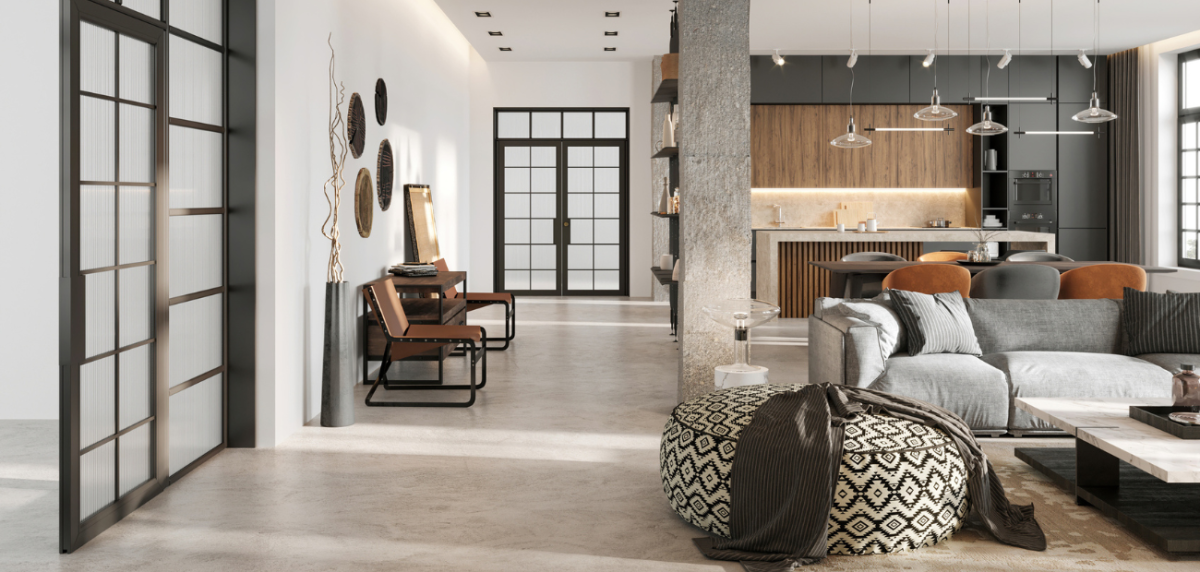
Whether it’s for textured walls or industrial-style flooring, concrete proves to be an ideal option for environmentally conscious clients seeking both chic aesthetics and easy upkeep.

Concrete has been a construction mainstay for a very long time. Perhaps that’s why many Americans consider concrete a purely functional material. But designers say this durable material can also add sleek sophistication and exciting texture to new homes and renovation projects.
One more point for concrete? It’s a sustainable material, making it a desirable option for the environmentally conscious. Recently, more than 50% of real estate professionals reported that their clients have shown an interest in sustainability, according to National Association of REALTORS® data.
Sustainable Concrete 101
As long as sourcing, production, and construction methods are considered, concrete makes for an incredibly sustainable material, according to designers.
Concrete’s durability reduces the need for frequent replacements, minimizing resource consumption over time, says Danielle Nash, project director and interior designer with Freemodel(link is external). “Concrete also can be recycled at the end of its life … and the techniques used in concrete production are energy efficient.,” she adds.
But the beauty of concrete is that it helps homeowners keep saving on energy and utility costs.
“Concrete’s thermal mass properties help regulate indoor temperatures, reducing energy consumption,” explains Bilal Rehman, interior designer and owner of Bilal Rehman Studio(link is external) in Houston. He says concrete’s potential to reflect sunlight can also reduce “the urban heat island effect” — the higher temperatures experienced in cities compared to surrounding rural areas.
Sustainable Concrete Trends in Home Design
Concrete, like cork or reclaimed wood, can be used in large-scale and small room renovations. It’s a versatile material that can add an industrial or earthy textural aesthetic, depending on its use in a space.
Here are five ways concrete can be used in upcoming personal or client construction and design projects.
Concrete Wall Finishes
Looking for a fun alternative to wallpaper or wood paneling? Nash and Rehman suggest concrete.
“Textured or stamped concrete used on walls adds visual interest and a unique tactile experience,” says Nash.
For a visual pop in new construction and remodels, Rehman loves the high-end, sophisticated look of a single concrete wall surrounded by conventional sheetrock walls.
Concrete Flooring
Concrete flooring has been used in garages and industrial spaces for decades. Today’s homeowners have a wide range of concrete flooring options that elevate the look of a space without adding complicated maintenance protocols.
Rehman opted for sleek black concrete floors in his Houston-based studio. “The concrete floors create an intense contrast to the more opulent elements like lighting and furniture, resulting in a captivating interplay,” he says.
Concrete Light Fixtures
Nash says minimalist pendant lights made of concrete are a great way to play with this material without committing to major changes like concrete walls or concrete flooring.
Unlike glass light fixtures, which emit a glow, opaque concrete shades and pendants act as spotlights. The way concrete pendants channel light in a single direction can help add a dramatic element to layered lighting schemes.
Concrete Countertops
Concrete’s durability and low maintenance make it ideal for kitchens and bathrooms.
Homeowners who have latched onto the minimalist decor trend will also appreciate concrete slab countertops’ sleek, modern appearance. Because pigments can be added to the concrete before it is poured, concrete countertops are available in every color. Finishing the countertop with a stain can even give the concrete a look that mimics natural stone, according to Angi(link is external).
Concrete Accessories
“For those that want to dabble and experiment with the use of concrete, accessorizing is a wonderful way to see if the look is something that suits your design needs,” says Nash. “Many [retailers] offer a wide range of accessories, ranging from coasters to sculpture art pieces for people to experiment with how much concrete to incorporate into their design.”
Finding Sustainable Concrete Resources and Retailers
Not all concrete products are the same. Homeowners should understand that unsustainable sourcing and production methods can counteract the low carbon footprint of the concrete product itself.
“Look for concrete suppliers in your local area that prioritize sustainability. Many suppliers provide information on their practices, such as the use of recycled materials or energy-efficient production methods,” says Nash, who also recommends asking architects, contractors or other homeowners for recommendations on sustainable concrete sourcing.
Wondering which retailers offer trendy concrete home decor and furniture? Both designers recommend CB2. Other recommendations include:
- West Elm(link is external)
- Holly Hunt(link is external)
- Umbra Shift(link is external)
- Concrete Cat(link is external)
“Concrete is definitely one of those materials just like rattan that circulates in and out of trend really often and really fast,” says Rehman. “When not in trend, you’re left with a few options like Etsy, vintage finds or even, dare I say, a little DIY moment.”
